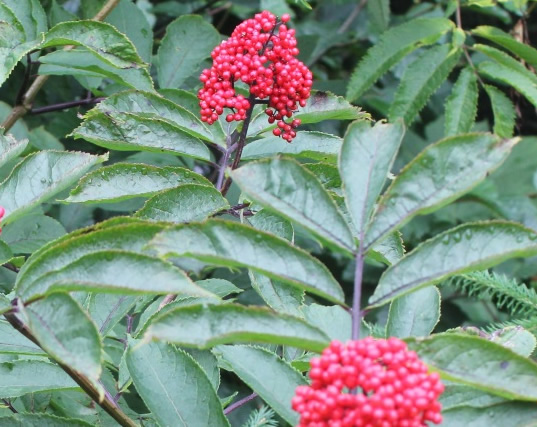Moutain Ash

Botanical Name: Sorbus sitchensis
Common Name: Mountain Ash (Sitka Mountain Ash)
Other Names: Esqunaq (word loaned by dena’ina peoples)
Found in: Open coniferous forest, stream banks, meadow edges and rockslides from middle to alpine elevations
Physical Characteristics: This shrubby tree, up to 9 feet tall, has reddish bark. Young twigs have rusty colored hairs. The leaves are arranged alternately on the stems and are pinnately (having parts arranged on each side of a common axis: a pinnate stem) divided into 7 to 11 notched leaflets. The small flowers are 5 petals and in rounded rather flat clusters at the ends of branches. Sitka Mountain Ash has large, round, reddish-orange berries with a bluish bloom (Pratt 1989). Mountain ash is a highly valued shrub that reportedly is not now as common in the Port Graham and Nanwalek area as it was earlier.
Nutritional Value: The berries are high in Vitamin C
Parts of the plant used: branches, leaves, cambium and fruit.
When plant should be gathered: Leaves alone and Branches w / leaves (switches) are gathered in the summer (some gather in July to dry for winter use, while others say late summer or fall is best because the leaves will not fall off the branches as easily when dried and used for switching, the berries are ripe in September and, finally, the cambium can be gathered in the winter.
Plant applications: decoction/tea/infusion, switch
Reported Benefits: Arthritis, childbirth, colds/flu, coughs/chest congestion, fever, hair problems, sore throat, pneumonia, stomach trouble, tuberculosis, headaches.
Preparation/Processing: Arthritis, colds/flue, coughs/chest congestion, fever, sore throat, pneumonia, stomach trouble and tuberculosis: These ailments were treated with large doses of an infusion of mountain ash leaves and cambium which was simmered for approximately one hour. The leaves were used primarily in the summer and the cambium used during the winter. Eating the raw fresh berries of the mountain ash treated respiratory trouble. (Russell 1991) Examples were given of people being cured of tuberculosis and other ailments by mountain ash.
Arthritis, colds/flue, cough/chest congestion, fever, pneumonia and headaches: A mountain ash switch was employed to relieve those ailments. (Russell 1991). Mountain Ash is the favorite switch of most people, probably due to its aromatic qualities and the belief that switching with it produces more body heat, sweating, and better circulation that switching with most other plants. People treat headaches by switching the back of the neck then placing very hot leaves there.
Childbirth: A mountain ash switch was quite popular with pregnant women who said it helped remove the gas from the body which provided more room for the fetus. Using the switch regularly was said to help facilitate the delivery and produce a healthier child. (Russell 1991)
Hair Problems: Hair growth was said to be accelerated with a treatment of a mountain ash infusion. (Russell 1991)
Warning: The leaves have cyanide in them, so don’t eat those raw.
